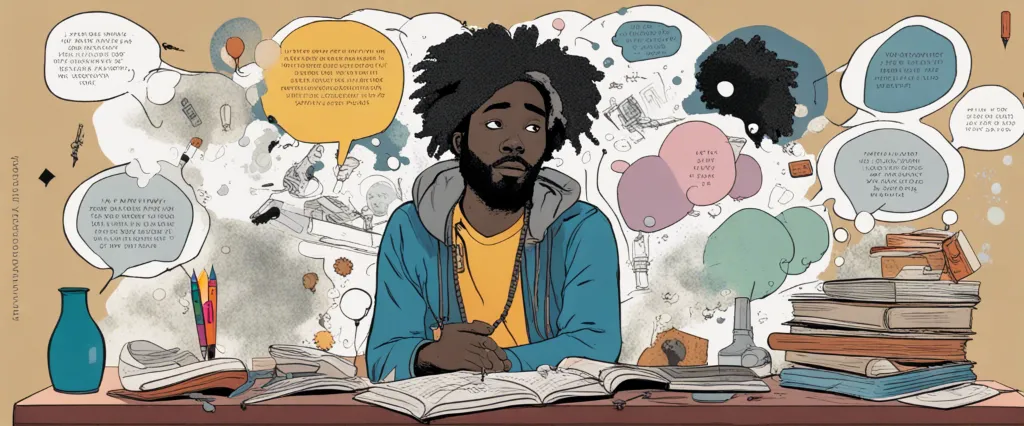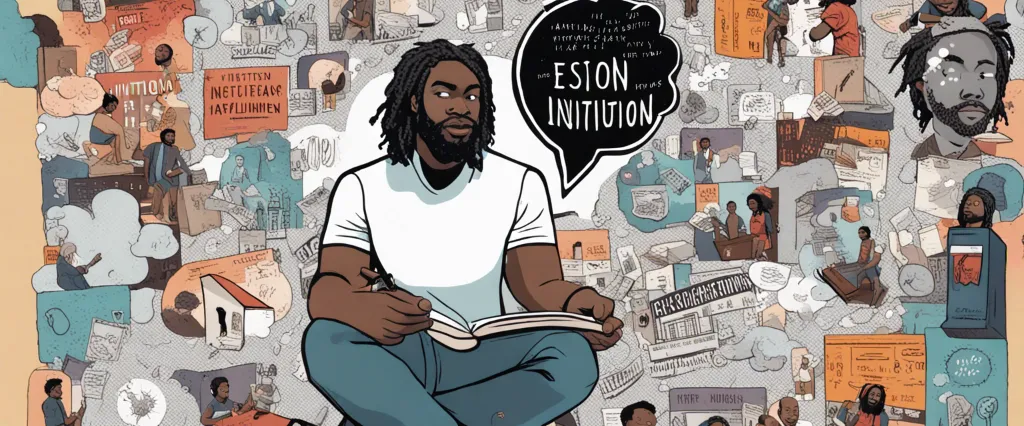In the eye-opening book, “Stamped,” Jason Reynolds fearlessly tackles the complex history of racism in America. With a captivating writing style, Reynolds sheds light on the deeply entrenched systems of oppression that have shaped society. As an acclaimed author and National Book Award finalist, Reynolds brings his own unique perspective to the topic, making this a must-read for readers of all ages. Through his insightful storytelling, he exposes uncomfortable truths, challenges conventional narratives, and encourages readers to actively engage in the fight against racism. In “Stamped,” Reynolds skillfully unpacks the origins of racism, demonstrating its destructive impact on individuals and communities alike, and ultimately empowering readers to forge a path towards a more inclusive future.
Chapter 1: The Roots of Racism: Remembering and Inheriting History
Chapter 1 of “Stamped: Racism, Antiracism, and You” by Jason Reynolds is titled “The Roots of Racism: Remembering and Inheriting History.” This chapter sets the stage for understanding the historical context of racism in America. Reynolds emphasizes that to fully comprehend the current racial issues, we must explore the origins and legacy of racism.
The chapter begins by highlighting the concept of time as a linear continuum rather than a cyclical pattern. Reynolds argues that this linear perspective allows us to understand history as a cause-and-effect sequence, making it clear how past events and ideologies influence the present.
Reynolds explores the roots of racism by taking readers back to the fifteenth century when Portuguese traders first engaged in the transatlantic slave trade. He describes how skin color became a defining factor in determining who was enslaved, with racial stereotypes and prejudices emerging during this time.
He then delves into American history, from the founding documents that paradoxically declared freedom and equality, yet only applied to certain individuals, mainly white males. Reynolds highlights the role of racism in shaping the formation of the United States, including the Three-Fifths Compromise and the preservation of slavery in various forms, even after its formal abolition.
The chapter also discusses the various tactics used throughout history to maintain racial inequality, such as systemic oppression, manipulation of language, and cultural appropriation. Reynolds emphasizes that racism is deeply embedded in America’s history and has left lasting scars on society, often perpetuated through generations.
Ultimately, Chapter 1 lays the groundwork for the subsequent chapters by establishing the historical framework of racism in America. It encourages readers to critically examine the narrative they have been taught about American history and to understand how the legacies of racism impact our lives today.
Chapter 2: Slavery and Racial Oppression: The Long Struggle of Black People
Chapter 2 of “Stamped” by Jason Reynolds explores the historical origins of slavery and racial oppression in the United States, focusing on the experiences of black people. The chapter begins by discussing how the transatlantic slave trade and the concept of race were intricately intertwined, as Europeans sought to justify their brutal exploitation of Africans through the framework of racial superiority.
Reynolds explains how notions of racial hierarchy were constructed, with blackness being associated with inferiority and white dominance. Slavery, as an institution, was deeply rooted in this belief system, which allowed for the dehumanization and exploitation of black individuals. Reynolds highlights key points in history that perpetuated slavery, such as the colonization of North America and the codification of slavery laws.
As the chapter progresses, Reynolds examines the various methods employed to maintain racial oppression beyond slavery’s abolition. He introduces the concept of white supremacy, detailing how it transcended the institution of slavery and became embedded in American society through methods such as Jim Crow laws, social segregation, and systemic racism. The chapter emphasizes that racial oppression evolved over time, adapting to fit the changing political and social landscape.
Reynolds emphasizes the resilience and resistance of black people throughout history, acknowledging their continuous fight against oppression. He highlights significant individuals and movements that challenged racial discrimination, such as the Civil Rights Movement and leaders like Rosa Parks and Martin Luther King Jr. He emphasizes the ongoing struggle for racial equality, noting that despite advancements, racism and white supremacy persist in different forms today.
Overall, Chapter 2 of “Stamped” provides a comprehensive overview of the origins and mechanisms of slavery and racial oppression in the United States, illustrating how these systems have shaped the experiences and struggles of black people throughout history.
Chapter 3: Forms and Evolutions of Racism: From Institutions to Microaggressions
Chapter 3 of the book “Stamped: Racism, Antiracism, and You” by Jason Reynolds explores the various forms and evolutions of racism from institutional racism to microaggressions.
The chapter begins by discussing how, historically, racism was institutionalized through laws and policies. Reynolds highlights how slavery, Jim Crow laws, and segregation were all deeply rooted in maintaining white dominance and oppressing Black people. However, these overt forms of racism eventually began to evolve as society recognized the need for change.
Reynolds then dives into the concept of covert racism, which emerged as a result of societal and legal changes. This form of racism operates subtly, often through institutions and systems, making it harder to identify and combat. He explains how covert racism shifted from overt racism after the Civil Rights Movement, with racial biases embedded within institutions like the education system, criminal justice system, and housing policies. The chapter emphasizes that although laws changed, the systems remained intact, perpetuating racial disparities.
Microaggressions are also explored in this chapter as an extension of covert racism. Reynolds defines microaggressions as subtle, often unintentional, acts and comments that demean and marginalize people of color. He discusses how microaggressions can contribute to feelings of isolation and the perpetuation of racial stereotypes. Reynolds also emphasizes the importance of recognizing and challenging microaggressions to promote inclusivity and respect for all individuals.
Overall, Chapter 3 of “Stamped” provides an insightful exploration of the different forms and evolutions of racism. It highlights the importance of understanding covert racism and microaggressions as persistent challenges in combating racial inequality.
Chapter 4: The Influence of Black Culture and Entertainment: Subversion and Celebration

Chapter 4 of “Stamped” by Jason Reynolds explores the influence of black culture and entertainment, focusing on both its subversive and celebratory aspects. Reynolds starts by discussing how African Americans have used music and other forms of entertainment to challenge and resist oppressive systems throughout history.
Reynolds explores the origins of African American music, highlighting how it has played a significant role in expressing the struggles and experiences of black people. From spirituals during slavery to the blues and jazz movements, music has served as a channel for expressing pain, resilience, and hope. Reynolds emphasizes that these art forms are not just means of entertainment, but powerful tools for pushing back against systematic oppression.
Another essential element discussed is the role of dance and fashion in black culture. Reynolds showcases how black artists have used dance and fashion as political and cultural statements, carving out spaces to express their identity and challenge mainstream norms. He frames these acts as subversive actions that assert black excellence and disrupt white-dominated culture.
However, Reynolds also emphasizes that black culture and entertainment are not solely about subversion and resistance. He acknowledges the importance of celebration within black communities. Artistic expressions rooted in joy, such as music festivals and cultural events, allow black people to come together, uplift one another, and celebrate their heritage.
Overall, this chapter highlights the deep-rooted connections between black culture, entertainment, and social justice. It underscores the ways African Americans have used artistic expressions to resist and challenge oppressive systems, while also recognizing the significance of celebration as a form of empowerment and cultural preservation.
Chapter 5: Consequences and Resistance to Racism: Black Self-Emancipation
Chapter 5: Consequences and Resistance to Racism: Black Self-Emancipation delves into the aftermath and repercussions faced by Black people as they fought against racism and sought their own freedom. Jason Reynolds illustrates how challenging it was for Black people to combat the deeply ingrained structures of racism and oppression.
The chapter starts by describing the strategies and tactics employed by white supremacists to maintain their dominance. They invested in various tools such as literature, segregation, and targeted violence to enforce racial hierarchy. These methods were intended to create deep divisions within the Black community, making it harder for them to unite and resist. Paradoxically, the more Black people resisted, the more they faced the wrath of white supremacists, resulting in severe consequences such as public lynching, economic exclusion, and social ostracization.
However, Reynolds also highlights the tremendous resilience and resistance shown by Black individuals and communities. They fought back through various means, including art, literature, speeches, and political activism. Black intellectuals, artists, and leaders emerged, challenging the dominant narrative and providing inspiration and hope for the Black community. The chapter touches upon influential figures like Ida B. Wells, who exposed the horrors of lynching, and the Harlem Renaissance, a cultural movement that celebrated Black art and expression.
Despite the challenges and violence they faced, Black people continued to rise and demand their emancipation. Their resistance to racism and oppression played a crucial role in advocating for change and fostering a sense of unity within the Black community.
Overall, Chapter 5 of Stamped emphasizes the consequences faced by Black people as they resisted racism, as well as the immense strength and resilience they displayed in the face of adversity.
Chapter 6: The System and Power of Racism: Who Holds the Center?
Chapter 6 of “Stamped” by Jason Reynolds is titled “The System and Power of Racism: Who Holds the Center?” In this chapter, Reynolds explores how racism is perpetuated through systems and institutions, focusing on the role played by white people in maintaining and benefiting from the system.
Reynolds begins by discussing the concept of white fragility, which refers to the defensiveness and discomfort white people often feel when discussing race. He emphasizes that understanding how racism operates within systems is crucial to dismantling it. He argues that the center of power in society is held by white people and that they have historically been the beneficiaries of racist policies and practices, even if unintentional.
The author delves into different institutions, such as education and media, which perpetuate racism. He explains how these institutions uphold and promote white superiority and control the narrative around race. Reynolds also highlights the role of white individuals in maintaining the system, citing examples of famous figures who either capitalized on racism or failed to use their influence against it.
Reynolds further examines the role of individuals, particularly white people, in challenging the system of racism. He emphasizes the importance of acknowledging the privileges white individuals hold and taking responsibility for dismantling racist structures.
In summary, Chapter 6 of “Stamped” explores the system and power of racism, with a focus on white people’s role in perpetuating it. Reynolds argues that understanding the systems that uphold racism is crucial to creating meaningful change and challenges white individuals to confront their privileges and actively work towards dismantling racist structures.
Chapter 7: The Future and Hope of Racism: Building a More Just World
Chapter 7 of “Stamped” by Jason Reynolds titled “The Future and Hope of Racism: Building a More Just World” offers readers a roadmap on how to dismantle racism and work towards a more equitable society. The chapter highlights the importance of education, imagination, and activism in bringing about positive change.
Reynolds stresses the vital role of education as a means to combat racism. He underscores that it is not enough to learn about racism; one must actively unlearn racial biases and critically examine the history and systems that perpetuate racism. Additionally, he emphasizes the significance of incorporating diverse voices and experiences in education to challenge the dominant narrative and create a more inclusive curriculum.
The chapter also explores the power of imagination in envisioning a more just world. Reynolds contends that imagination can be a tool for resistance and that we must imagine a society free of racism to strive towards it. By embracing empathy and understanding the experiences of marginalized groups, individuals can work towards dismantling racial injustices.
Furthermore, Reynolds encourages readers to become conscious activists. He argues that complacency only perpetuates racism and that individuals must engage in meaningful ways, such as supporting anti-racist organizations, voting for representatives who advocate for equality, and engaging in conversations surrounding race and privilege. Taking action, even in small ways, can contribute to the larger fight against racism.
In summary, Chapter 7 of “Stamped” emphasizes the importance of education, imagination, and activism as tools to combat racism. By actively unlearning biases, embracing diverse perspectives, envisioning a more equitable society, and advocating for change, individuals can contribute to building a future free of racism and fostering hope for a more just world.

Chapter 8: Our Individual Responsibilities: Taking Anti-Racist Action
In Chapter 8 of the book “Stamped” by Jason Reynolds, titled “Our Individual Responsibilities: Taking Anti-Racist Action,” Reynolds focuses on the individual roles and responsibilities in combating racism. He emphasizes the importance of not being a passive bystander and instead actively engaging in anti-racist actions.
The chapter begins with Reynolds acknowledging that fighting racism is not an easy task. He compares it to mountain climbing, emphasizing that it requires effort, endurance, and determination. Reynolds advises readers to question the narratives fed to them and to conduct their own research, advocating for critical thinking. He emphasizes the need to be aware of one’s biases and to challenge them.
Furthermore, Reynolds highlights the importance of having conversations about racism. These discussions could take place with friends, family, or colleagues, and can help raise awareness, educate others, and foster empathy. He encourages readers to have uncomfortable conversations because they are necessary for growth and progress.
Additionally, Reynolds stresses the significance of voting, as political power directly affects policies related to racism. He argues that voting is a fundamental way for individuals to make their voices heard and create change, especially in local elections.
Reynolds also emphasizes the role of education in tackling racism. He advocates for a more comprehensive and accurate teaching of history, exposing the true extent of racism that has existed in shaping society. By understanding the past, individuals can challenge the present and work towards an equitable future.
In conclusion, Chapter 8 of “Stamped” underscores the individual responsibility we all have in fighting racism. Reynolds encourages readers to educate themselves, engage in difficult conversations, vote, and continuously challenge their own biases. By taking these actions, individuals can contribute to a more just and anti-racist society.
After Reading
In conclusion, “Stamped” by Jason Reynolds offers a powerful and enlightening exploration of the history of racism and its impact on society. Reynolds skillfully breaks down complex historical events and ideologies, making them accessible and engaging for readers of all ages. Through an engaging narrative and thought-provoking analysis, Reynolds emphasizes the importance of understanding history in order to create a more inclusive and just future. His book serves as a reminder that recognizing and confronting racism is an ongoing and necessary process that requires the involvement of every individual. “Stamped” is a compelling call to action, urging readers to actively challenge and dismantle systems of oppression in order to create a more equitable world.
1. “The Hate U Give” by Angie Thomas – This powerful novel explores themes of racial injustice and follows a young girl named Starr as she navigates the aftermath of witnessing her friend being shot by a police officer.
2. “Just Mercy: A Story of Justice and Redemption” by Bryan Stevenson – Written by renowned lawyer Bryan Stevenson, this gripping memoir recounts his experiences fighting for the rights of marginalized individuals and his tireless efforts to abolish the death penalty.
3. Brown Girl Dreaming” by Jacqueline Woodson – This award-winning autobiography in verse chronicles the author’s upbringing as an African American girl growing up in the 1960s and 1970s in South Carolina and New York.
4. “The New Jim Crow: Mass Incarceration in the Age of Colorblindness” by Michelle Alexander – Michelle Alexander presents a thought-provoking analysis of the U.S. criminal justice system, connecting racial discrimination to the cycle of mass incarceration.
5. “Between the World and Me” by Ta-Nehisi Coates – This profound memoir considers the experience of being black in America and the challenges faced by African Americans, particularly in the context of police violence and systemic racism. Coates addresses these issues through a series of letters to his adolescent son.




